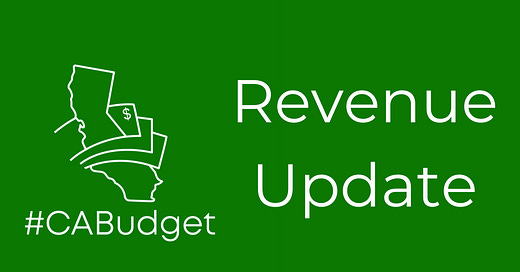LAO: challenging 25-26 revenue outlook
Forecasters' economic growth expectations "among the lowest in...history"
“Muted Expectations Moving Forward.” The Legislative Analyst’s Office (LAO) released its annual May revenue outlook, anticipating that state General Fund tax revenues across 2023-24 and 2024-25 will be over $5 billion above January administration projections, while 2025-26 revenues will be $7.8 billion below the January projections. The growth for 2023-24 and 2024-25 revenue is consistent with recent revenue trends, fueled by stock market gains over the past two years, but LAO affirms widespread sentiment that there are “muted expectations moving forward.”
Revenue Slowdown Projected for 2025-26. Under LAO’s updated projections, the General Fund’s three largest taxes (personal income tax, corporation tax, and sales tax) would total $184.0 billion in 2023-24, $200.6 billion in 2024-25, and $198.7 billion in 2025-26. By contrast, the Governor’s January budget proposal anticipated those sources would total $181.0 billion in 2023-24, $198.4 billion in 2024-25, and $206.5 billion in 2025-26. Next week’s May Revision from the administration will include new estimates, which, based on historical experience, are likely to be the ones used in the final budget package for 2025-26, to be passed next month. (For my part—and I always pledge humility in making projections—I suspect 2024-25 revenues will end up somewhat above LAO’s estimates when the books close next year, but 2025-26 revenues could end up much lower than LAO’s new estimates due to the federal administration’s discretionary and, frankly, very weird choices to tank the U.S. economy.)
“Federal Policy Turbulence Puts Fragile Economy at Risk,” LAO Notes. The risks to California’s economy and a “potentially overheated stock market” have been magnified by “recent federal policy actions,” such as tariffs that “will create new costs for consumers and businesses and likely place some drag on the economy,” LAO analysts write. The LAO notes declining consumer sentiment, which often puts pressure on the state’s labor market and revenues, and weakening expectations among economic forecasts. “According to a long-standing survey of forecasters (Blue Chip Economic Indicators),” LAO notes, “expectations for gross domestic product growth over the next few quarters are among the lowest in the survey’s history.” “Survey readings have only been this low three times,” the post adds.
Attribution of Revenue by Fiscal Year Is Noteworthy. LAO’s outlook attributes some revenue gain to 2023-24, as well as 2024-25. While monthly state revenue reports—including my own—focus on overall, net revenues, different types of receipts or refunds embedded in the monthly data can affect which fiscal year tax revenues are “accrued” (attributed) to. Proposition 30/55 revenues, for example, are accrued pursuant to a specific formula first proposed by the executive branch in 2011. While the final budget likely will be based on the Department of Finance’s May Revision revenue estimates, if revenues shake out in 2023-24 and 2024-25 as LAO projects, higher revenues in 2023-24 may lower the year-over-year revenue growth rate and moderate required Proposition 98 maintenance factor payments for 2024-25. After this June’s budget, 2024-25 revenue estimates will continue to change through mid-2026. Because the state is paying down maintenance factor this fiscal year, future changes in 2024-25 revenue projections after this June may boost or reduce the 2024-25 Proposition 98 guarantee—potentially on an almost dollar for dollar basis.
May Revision Likely to Project Significant Deficits in Future Years. While the lower 2025-26 revenue projection forebodes some deficit estimate in the May Revision, the strong recent revenue trend—coupled with the planned use of part of the rainy day fund from last year’s budget package—suggests this year’s deficit will be only a moderate one, perhaps over $10 billion. That being said, future years’ estimated deficits likely will be more significant, and there will be a need for the state to take difficult actions this year to begin to lower those future deficit projections. State officials will find it difficult to avoid cuts to projected growth in health and social services programs, as well as higher education, housing, and natural resources programs, to begin lowering future projected deficits. Other budget-balancing actions are possible too, including actions to increase state tax revenue, borrow from ample balances in other state funds, shift General Fund spending to other sources such as bonds and special funds, delay planned expenditures, etc., etc.
More Budget-Balancing Action Likely Needed After June. The May Revision deficit estimates will not be able to account for the possible future federal cuts to Medicaid and other programs, and additional economic deterioration is quite possible. Accordingly, additional budget action may be needed after passage of the 2025-26 state budget in June—perhaps prior to the legislative recess in September, perhaps during the fall, or perhaps during the opening weeks of 2026. The state will not be able to backfill many federal cuts, as it is already facing challenges in funding existing state programs.



